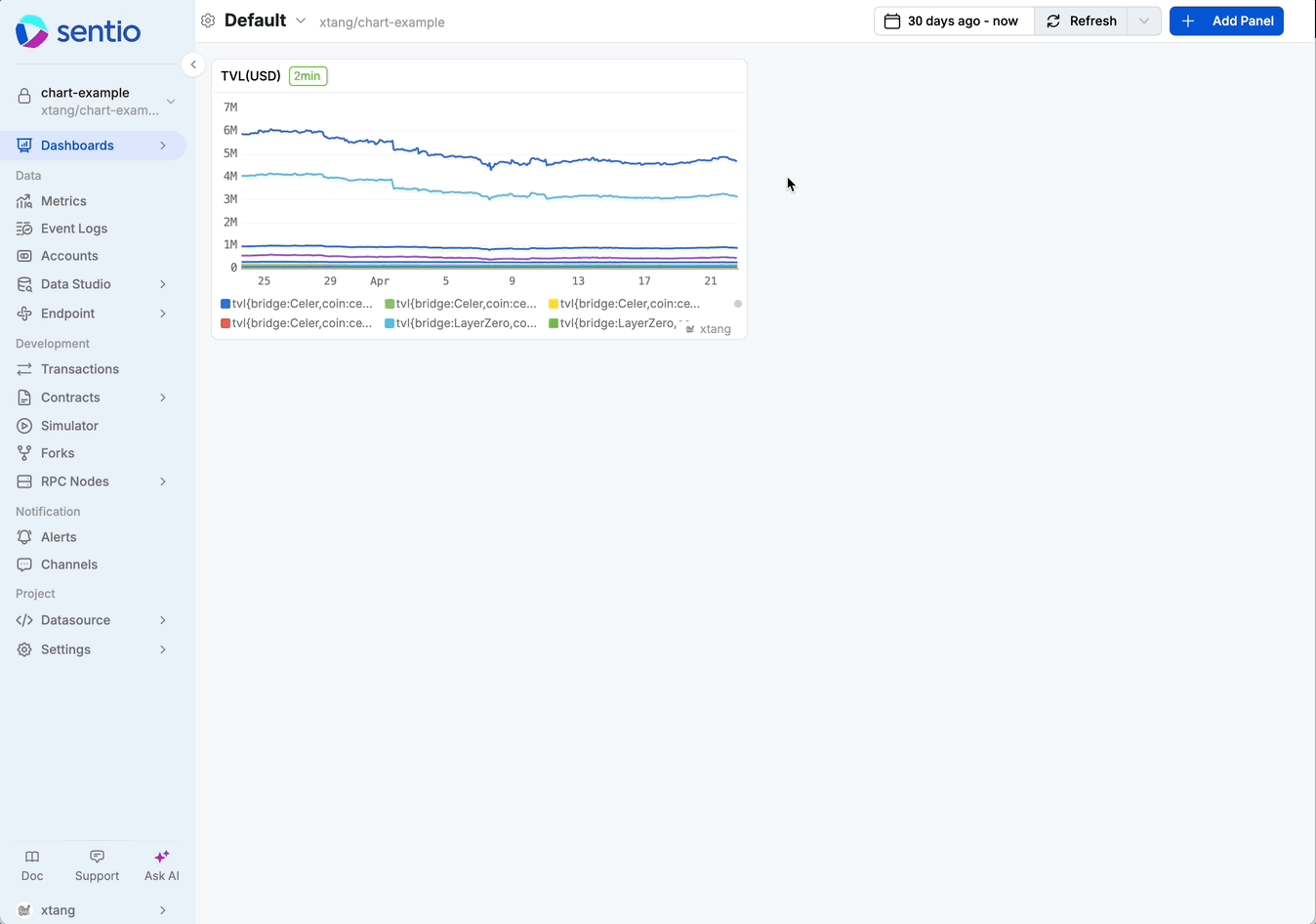🧭 Metrics
Metrics represent numerical data points associated with a timestamp. They are ideal for tracking trends, aggregations, and setting up alerts based on numerical thresholds.
Accessed via: ctx.meter
Currently, we support two types of metric data.
Counter
- Represents a cumulative value that only increases (or decreases if you add negative values, though less common).
- Each
.add(value)call adds thevalueto the current total for that time series. - Use Cases: Total volume transferred, total fees collected, number of events occurred, cumulative user count.
- Example:
const totalVolume = Counter.register('total_volume', { unit: 'eth' }); // ... in handler ... totalVolume.add(ctx, event.args.value.scaleDown(18)); // Add transferred amount
Gauge
- Represents a value that can arbitrarily go up or down at any point in time.
- Each
.record(value)call sets the value for that specific timestamp, replacing any previous value at that exact time (though usually recorded at different timestamps). - Use Cases: Current balance, total supply, price, pool liquidity ratio, temperature, queue length.
- Example:
const currentBalance = Gauge.register('current_balance', { unit: 'token' }); // ... in handler or interval ... const balance = await contract.balanceOf(address); currentBalance.record(ctx, balance.scaleDown(decimals)); // Record the current balance
Series
It is possible to have multiple series in one metric (i.e., Counter or Gauge). Any label combination generates a different series (see #labels). For example, if you have a metric which uses a token symbol as a label, you'll generate multiple series in the dashboard by default. For example:
%20(1)%20(1)%20(1)%20(1).png)
You can easily sum them by using #space-aggregation

Submitting Metrics
The simplest way to submit a metric is to call ctx.meter inside handler function, e.g.
async function handleTransfer(event: TransferEvent, ctx: ERC20Context) {
ctx.meter.Counter('token').add(event.args.value)
}Metric Naming
A metric name can contain characters, digits, or _. Any other characters will be converted to _. It will also be truncated to 512 characters.
Reserved Suffixes:When naming Sentio Metrics, avoid using suffixes like _count, _sum, _avg, _min, _max, _last, or _resolute as these are reserved by the system.
Labels
Labels is a map of key to string values. The key name follows the same rule as the metric name, and any reserved keywords will be appended with _.
Our system automatically adds a few reserved labels, including chain, version, contract_name, contract_address, aggregation_minutes, aggregation_days. If users use these labels, an error will be returned and visible on the UI.
You can also add your own custom labels to differentiate the characteristics of the thing that is being measured. For example:
tvl.record(ctx, v, {coin: coinInfo.symbol, bridge: coinInfo.bridge, type: coinInfo.token_type.type})This submits TVL with symbol being used as a label.
Assuming there are N symbols, M bridges and K coin types, the total number of series generated could be as large as N * M * K (but won't exceed the total number of points submitted). Read avoid-high-cardinality for more details.
Descriptor
Sometimes you want to give the metric more information, or want to share the same counter/gauge in different handler functions. In these cases, you can first declare your counter with an optional descriptor.
const tokenCount = Counter.register(
'token_count',
{ description: 'token transferred to my wallet',
unit: 'eth'
})and then use them as
async function handleTransfer(event: TransferEvent, ctx: ERC20Context) {
tokenCount.add(ctx, event.args.value)
}Resolution
You can define pre-aggregation rules for the metrics
export const gaugeOptions: MetricOptions = {
sparse: true,
aggregationConfig: {
intervalInMinutes: [60],
discardOrigin: true,
}
}
export const vol = Gauge.register("vol", gaugeOptions)This will generate 2 new metrics vol_count and vol_sum.
- vol_count represents the count of data pre-aggregated every 60 minutes.
- vol_sum represents the sum of data pre-aggregated every 60 minutes.
- The original metric vol will be omitted since
discardOriginis true.
We only support resolution of
gaugeat this point.
Updated 3 months ago
